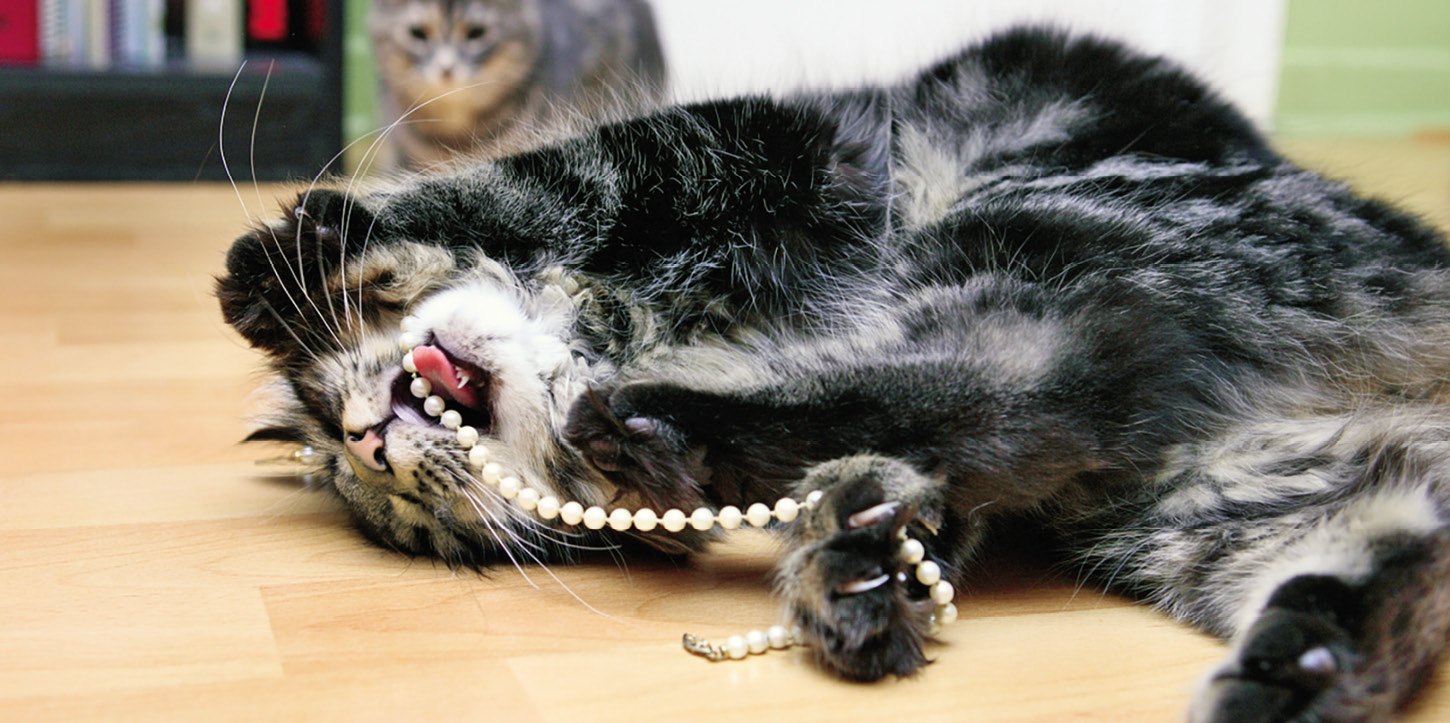Cats are curious by nature and love to investigate objects with different shapes and textures. This includes picking things up, tasting them, tossing them around, and sometimes swallowing them. Linear objects like string, thread, yarn, tinsel, and dental floss are especially dangerous.
“Due to their unique tongue anatomy (little backward pointing projections), if they ingest string or ribbon, they tend to swallow it, not spit it out,” says board-certified veterinary surgeon Jan MacDonald, DVM, Cornell 1987. “If the object becomes tethered at some position, like under the tongue, the swallowed end will cause the intestines to bunch up with normal gut movements. This can lead to severe injury to the intestines, even rupture.”
Signs of linear foreign body ingestion in cats include:
- Abdominal pain
- Fever
- Gagging
- Hiding
- Lethargy
- Loss of appetite
- Vomiting
- Death
If you know your cat was playing with string—or had the opportunity to do so—and he starts showing any of these signs, get to the veterinarian right away. Your veterinarian will do a thorough oral exam, checking underneath the tongue for string that may have looped around the base of the tongue. The cat’s degree of pain is assessed by abdominal palpation, which may also reveal abnormally bunched or firm intestines.
At the Clinic
Abdominal x-rays and/or ultrasound are used to diagnose an intestinal blockage. In the case of string foreign bodies, the blockage is caused by bunching up of the intestines, which accordion up on themselves, held tightly together by the string. This causes not only a blockage, but also severe damage to the lining of the intestines. “The string can actually ‘saw’ its way through the intestinal wall, causing leakage of intestinal contents into the abdomen,” says Dr. MacDonald. “This can lead to life-threatening peritonitis (inflammation of the lining of the abdominal cavity) or death.”
Treatment
Treatment requires aggressive supportive care with intravenous fluids, antibiotics, and emergency surgery. The surgery can be extensive. “Oftentimes the surgeon needs to make multiple small incisions in the cat’s stomach and intestines to gently relieve the bunching and remove the object without causing further damage to the intestines,” says Dr. MacDonald. It is not unusual for there to be more than a dozen incisions made throughout the intestines, with small lengths of the string removed at a time. This results in a lengthy and expensive procedure.
Recovery
Once your cat makes it out of surgery, he’s still not out of the woods. Recovery from this painful situation and surgery can be a rocky road. Infection is a huge potential complication. Pain, despite our best efforts to control it, can lead to a complete loss of appetite, which in and of itself can become life-threatening in cats (see “Deadly Decreased Appetite” on page 3).
 Post-op anorexia sometimes necessitates placement of a feeding tube. Either way, your cat will likely spend several days in the hospital after surgery, with careful monitoring, intravenous fluids, pain medications, and antibiotics, before being sent home.
Post-op anorexia sometimes necessitates placement of a feeding tube. Either way, your cat will likely spend several days in the hospital after surgery, with careful monitoring, intravenous fluids, pain medications, and antibiotics, before being sent home.
Don’t Bother the String
You may be tempted to just cut the string if you can see it looped around the tongue. Or, if it’s sticking out of his anus, you may decide to pull it out. Don’t!
If your cat is showing any of the above signs, it means there is already a bunching of intestines and likely intestinal obstruction. “Simply cutting the string may not solve the intestinal bunching,” says Dr. MacDonald. “Pulling on a string protruding from the anus in a cat with signs of intestinal blockage is likely to cause further damage to the intestines.” Sadly, there’s really no way out of this other than emergency surgery.
Preventing linear foreign bodies in cats is obviously a much better approach than having to treat them. According to Dr. MacDonald, simply not leaving yarn or thread in an area a curious cat can find it is the best option.




